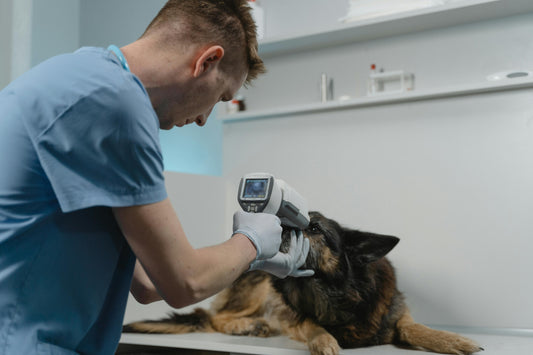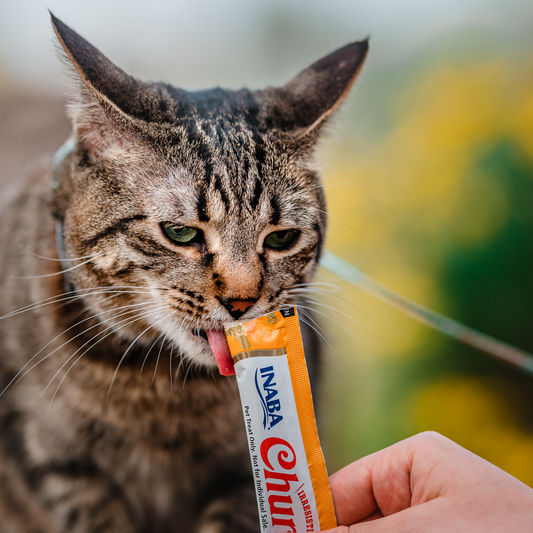Gingivitis in dogs can be easy to miss in the early stages, but it’s more common than most pet parents realise. Just like in humans, it begins with a buildup of plaque that irritates the gums, leading to inflammation, discomfort, and, if untreated, more serious dental disease.
So what does dog gingivitis look like, and how can you tell if your pup might be dealing with it? We’ve put together all the information you need to know in one place.
Signs of Gingivitis in Dogs
The hallmark sign of gingivitis is red, swollen gums. Healthy canine gums should be a firm, bubblegum pink. You may also notice that the gum line appears puffy or uneven, particularly where the teeth meet the gums. In more advanced cases, the gums may start to recede, revealing more of the tooth than usual.
Dogs with gingivitis often show subtle changes in behaviour, like pulling away during pats around the mouth, pawing at their face, or chewing on one side of the mouth. Some dogs may become less interested in dry food or hard treats if chewing causes discomfort.
What You’ll See in Pictures of Dog Gingivitis
If you're searching for pictures of dog gingivitis, you're likely to come across a range of severity. Mild gingivitis may present as slight pinkness or puffiness near the back molars. In moderate cases, you’ll see distinct redness, minor bleeding when touched, or small pockets between the teeth and gums. Severe gingivitis might involve ulceration, significant gum recession, and heavy plaque or tartar buildup along the gumline.
Visuals can be helpful, but an in-person dental check is always the most accurate way to assess your dog’s oral health. A vet can use specialised tools and lighting to identify areas you may not be able to see clearly at home.
Early Detection is Key
Spotting the first signs of gingivitis gives you a chance to intervene before the condition worsens. If your dog has chronic bad breath, it could be a red flag that bacteria is accumulating in the mouth. Other symptoms include a yellow or brown film over the teeth, increased drooling, and visible discomfort when eating.
Regular at-home checks can go a long way in early detection. Lift your dog’s lip gently and observe the gum line. If anything seems inflamed or irritated, it’s worth a visit to the vet.
Dog Gingivitis Treatment Options
Dog gingivitis treatment typically starts with a professional dental cleaning under anaesthesia, which allows the vet to remove plaque and tartar from below the gumline. In some cases, antibiotics may be prescribed to reduce bacterial load, especially if an infection is present.
After cleaning, your vet might recommend at-home maintenance like brushing or medicated oral gels. If gingivitis is left untreated, it can progress to periodontitis, where the bone and tissue supporting the teeth begin to break down.
Preventing Gingivitis: Dental Chews & Brushing
Routine dental care at home can significantly reduce your dog’s risk of developing gingivitis. One of the easiest preventative measures is using specially formulated dog dental chews These chews are designed to help remove plaque mechanically while your dog chews, and some contain ingredients that target bacteria in the mouth.
That said, chews aren’t a substitute for brushing. To really stay ahead of plaque build-up, brushing your dog’s teeth regularly is essential. Not sure how? Follow our step by step to brush dog's teeth for tips on what tools to use, how to introduce brushing gradually, and techniques that work on even the squirmiest of pups.
Watch What Your Dog Eats
What your dog eats plays a major role in their dental health. Crunchy kibble isn’t enough to help reduce plaque build-up c. Adding nutritious dog food that supports dental and gum health is a smart move. Some formulas even include ingredients like zinc or vitamin C, which are known to promote gum tissue repair and reduce inflammation.
In addition to main meals, look at what you’re using for rewards. Sticky or sugary treats can speed up plaque formation, so opt for raw bones, fresh foods and healthy dog treats that are low in sugars & starch and absolutely free from fillers.
Could It Be Something Else?
While gingivitis is common, it’s not the only cause of gum inflammation. If your dog’s gums are red but there’s also visible damage to the teeth or they’re showing signs of severe pain, other conditions may be at play, like tooth resorption. This increasingly recognised dental issue can look a lot like gingivitis, but involves the gradual breakdown of a tooth’s structure below the gumline. Want to know more? Read our full guide about what is tooth resorption in dogs and how veterinary professionals diagnose it.
When to See the Vet
If you notice any of the following, book a dental check-up with your vet:
- Bleeding gums after chewing or brushing
- Persistent bad breath
- Sudden refusal to eat hard food or toys
- Gum swelling or discolouration
- Visible tartar or loose teeth
Waiting too long can make treatment more intensive and costly. In many cases, tooth loss and systemic infections are more likely. A simple dental scale and polish caught early is far less invasive than needing extractions due to periodontal disease.
If you’re unsure whether your dog has gingivitis, trust your instincts: bad breath, gum redness, and changes in eating are all signs that something might be off. The sooner you act, the better the outcome.




